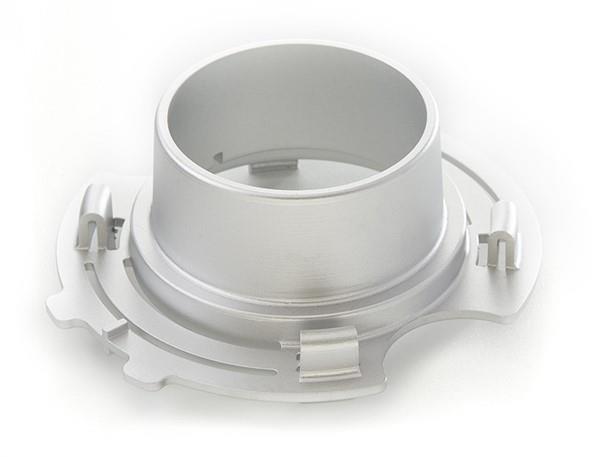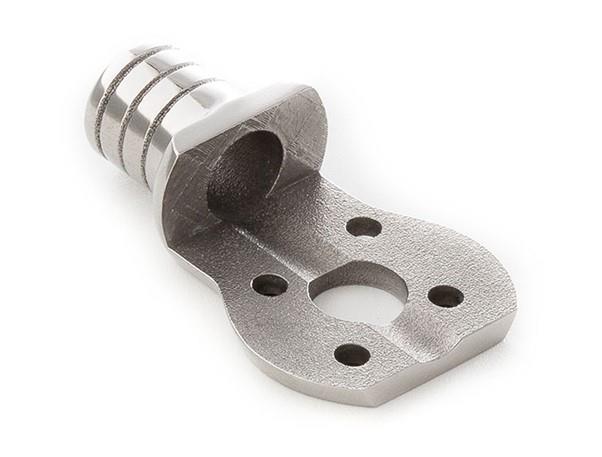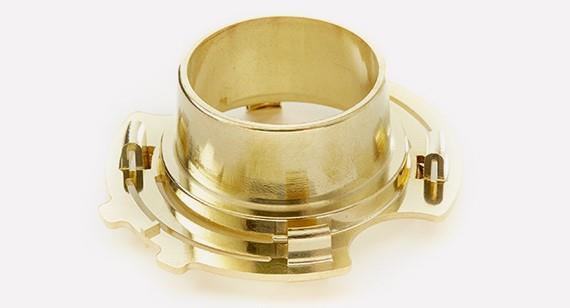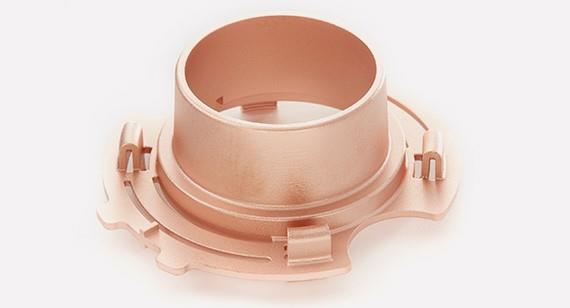Many metals have similar superpowers. While iron and its offspring carbon steel will quickly rust if not protected with paint, plating, and similar coatings, others such as aluminium and stainless steel react with the oxygen in the air to form a thin protective shell known as a passivation layer. More on that shortly.
We won’t delve into the electrochemical mechanisms that cause rust in all its various forms to develop—it’s a complex topic, of interest mainly to metallurgists and material scientists. We will point out, though, that it happens more quickly in the presence of humid air and water, especially saltwater, and that even the tallest building and mightiest bridge will eventually fail because of it.
The good news is that a broad selection of corrosion-resistant metals is available, and we machine, and 3D print the most often used ones. Here’s a quick overview of each, along with a few application examples:
Aluminium
This element is an excellent choice for a host of applications. Its many alloys are strong, lightweight, non-magnetic, and electrically conductive, making them suitable for everything from cooking utensils and lawn furniture to machinery hardware, electronics housings, and scientific instruments.
We carry five CNC grades of aluminium, and a 3D printing grade. 6082-T651, very similar to 6061, it is a general-purpose alloy that is readily milled, turned, laser-cut, bent, formed, and welded. 7075-T651 and 7075-T7351, both are used in the aerospace industry, the latter is tougher and more durable. 5083-H111 is more corrosion resistant, as it contains more magnesium. 2024-T351 is another aero grade, specifically for components in tension, it is fatigue resistant.
And for 3D printed parts, there is AlSi10Mg, a tough grade of aluminium long used for castings. Oh, and the thin, protective layer mentioned earlier? In aluminium, it’s called aluminium oxide, an exceedingly hard chemical compound found in many grinding wheels. If you want a tougher coating, you can turn to anodising, too.

This bead-blasted aluminium flange was peppered with small, glass beads, yielding an attractive, smooth appearance and feel. Corners are smoothed out, as well, to avoid sharp edges on this machined part. As with all aluminium parts, it is highly resistant to corrosion.
Titanium
Let’s start by mentioning that this lightweight metal is pricey. If that doesn’t bother you, read on! Metallurgists will tell you it’s just as strong as steel but at half the weight; and twice the strength of aluminium but only one-and-a-half times the weight. Metal trivia aside, titanium is also one of the most corrosion-resistant metals thanks to its generation of a titanium oxide coating when oxygen is present (which it almost always is).
We rightfully label titanium Ti6Al4V (grade 5) as a "workhorse alloy" for its widespread use in medical implants, aircraft engines, power generation facilities, sporting equipment, and other applications that extensively use this important alloy for machining and 3D printing.

Polishing titanium has no effect on its toughness or corrosion-resistance. It does do a great job of brightening the surface, and best of all, titanium is also resistant to many acids, saltwater, and chemicals.
Stainless Steel
This steel alloy gets its protective layer from chromium oxide. That’s because the element that gives all stainless steels their name is chromium. 304, or A2 is a good “general-purpose” grade, used for cutlery and freshwater applications. 316, or A4, stainless steel, is a tougher, more heat, wear, and corrosion-resistant grade thanks to 2 percent molybdenum. It is often called marine grade, as it will resist saltwater corrosion (at room temperatures). Each of these also comply with the requirements of "low carbon" grades denoted by an “L” for example 304L and 316L. They are slightly softer and more weldable. Finally, here comes another aerospace favourite, 17-4 PH (short for precipitation hardening). Unlike 300-series stainless steels, 17-4 can be hardened by heat treatment, so is often found in gas turbines, petrochemical applications, and aircraft parts.
Cobalt Chrome
This alloy boasts many of the same mechanical attributes as stainless steel but is slightly stronger and more wear resistant. Thanks to its biocompatibility, you might be wearing a cobalt chrome wedding band on your hand, dentures in your mouth, or a replacement joint in your knee or hip, although cobalt chrome is also common in many industrial applications such as furnace liners and engine components. And while the stainless steels just listed are regular visitors to the CNC mills, lathes, and direct metal laser sintering (DMLS) at Protolabs, the cobalt chrome superalloy Co28Cr6Mo is currently limited to DMLS 3D printing.
Inconel
This is another unique DMLS-only offering. That’s because this superalloy is quite challenging to machine (like all superalloys) but is readily 3D-printed into parts as large as 400 mm × 800 mm × 500 mm (31.5 in. × 15.7 in. × 19.7 in.) on some of our printers. Like 17-4 stainless steel, Inconel 718 is precipitation-hardenable but contains far higher amounts of nickel (around ten times as much) along with 5 percent or so of the refractory metal niobium and nearly that much molybdenum. This explains its great strength and high heat capabilities, making it a preferred material for any component subject to temperatures up to 700 °C (1,300 °F) and extreme mechanical loading. And yes, it’s resistant to corrosion of all kinds.
Brass
An alloy of copper and zinc, this sits at the opposite end of the machinability chart from Inconel, titanium, and cobalt chrome. That doesn’t make it any less valuable, though, especially to those looking for a corrosion-resistant, easily machined metal. It is useful for plumbing fixtures and adapters, bearings, heat sinks, threaded fasteners, and any other parts requiring high electrical and thermal conductivity. Protolabs stocks two types of brass. So-called free-cutting brass C360 (Cz121 or CuZn36Pb3) that gets its name from a trace amount of lead, which eases machining and makes this yellow metal quite popular for high-volume screw machine work. Similarly, alloy C464 (Cz112 or CuZn36Sn1) is known as naval brass, for its excellent corrosion resistance and subsequent use in marine components. For turned and milled parts, brass is an attractive alternative with many admirable qualities, not the least of which is its good looks.

Look closely at this machined brass flange to see its broken-edge finish. Parts with broken edges have radii or chamfers machined into them to avoid sharp, edges, softening their appearance.
Copper
Finally on our corrosion-resistant hit parade, copper grade—C101. It ranks among the planet's most electrically—and thermally—conductive materials. Copper overlaps to some extent with brass in terms of its various applications, but is generally more formable, less machinable, and a bit more expensive. It's a great choice for high-performance heat exchangers and electronic or electrical applications (EMI shielding, for instance). And thanks to its anti-microbial properties, copper is enjoying increased use in hospital equipment.

Copper offers an aesthetically pleasing product that can corrode over time, but in a different way. Over time, carbon and oxygen molecules attach to the copper to form a layer of copper carbonate, or patina, an attractive and protective blue-green surface.
Seen enough? It should be evident now that we have plenty of corrosion-resistant metals to choose for your next project. And there is no shortage of ways to quickly convert these metals into precision parts, whether it’s via CNC turning, milling or metal 3D printing.
Before we let you go, it's also worth noting there are a host of engineering-grade polymers available that might fit your needs, and rust-prone metals such as low-carbon steels and EN8 alloy can be made more weatherproof with the proper surface treatment. Please be aware that such treatments might also be necessary on some of the metals just discussed. Aluminium, for instance, typically needs anodising, just as stainless steel materials should be passivated for improved corrosion resistance.
Also, we encourage you to check out the extensive listing of material data sheets available on our website for additional details. They can offer you even more details about the corrosion-resistant metals listed above. If you have any questions, drop us a line. Our applications engineers are always available to help at +44 (0) 1952 683047 or customerservice@protolabs.co.uk.
